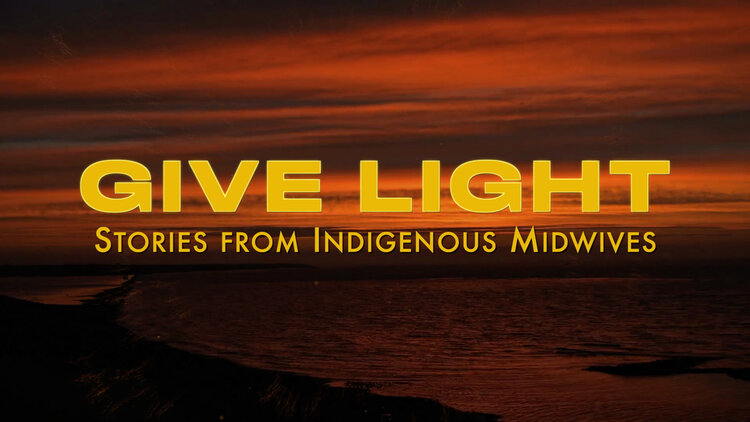Thank you for coming to view and support the film.
We want to use this questionnaire to understand what people’s perceptions are of midwifery so that we can better support midwives and develop better educational resources. The questionnaire is anonymous unless you choose to share your email at the end.
You’ve seen Give Light: Stories of Indigenous Midwives, now what?
Let’s start with some vocabulary…
Midwives and Medicaid
45% of the births in the US are covered by Medicaid, including 70% of births in Louisiana
Reimbursement rates vary, but it is safe to say that it ranges from the low of $875 in Louisiana for all prenatal, birth and postpartum care by a provider to $1540 in California
The low pay rates make it practically impossible for non-nurse-midwives to attend home or hospital births covered by Medicaid. Even at a birthing center, where Medicaid will cover a “facility fee” it is difficult for midwives to practice under Medicaid.
This creates a problematic barrier in a few ways
First, it makes it difficult for low-income people, who already face disproportionate difficulties accessing adequate maternal healthcare, to access midwives if their insurance will not cover it.
Second, it makes it difficult for midwives to practice by limiting their pool of patients.
-
Give Light introduced some of the many benefits of midwifery. Midwives aid in childbirth in a noninvasive manner, allow families to maintain their cultural and spiritual practices, and help support enforce maternal autonomy. They provide prenatal, birthing, and postnatal care, which is especially important for rural or marginalized communities that often have limited access to such care. Their philosophy encourages empowering the birthing experiences across social and economic status. In addition, research has found that midwifery-led care is associated with many health benefits such as fewer episiotomies and reduced likelihood of preterm birth–and lower costs (Sandall et al., 2016). There were also no identified downsides in comparison to medical-led care (Sandall et al., 2016).
-
Studies show no significant difference in maternal morbidity and mortality between midwife-attended births and births where no midwife was in attendance (Janssen et. al., 2009). Midwife-attended births have lower rates of cesarean sections and episiotomies (Attanasio & Kozhimannil, 2018). While more research is needed, studies show that midwife-attended home births have lower rates of perinatal death, infants that need resuscitation at birth, and infants that need supplemental oxygen after 24 hours (Janssen et. al., 2009).
-
Midwives are accustomed to managing high-risk pregnancies. While they may not have the scope of practice to prescribe some medications or treatments, they can work with OB/GYNs to help the pregnant person. It is important to remember that there are a wide range of factors that can cause a pregnancy to be deemed high-risk, and that can be different for doctors and midwives. Do not rule out a midwife if you have been deemed high-risk; instead, talk to local midwives and see what they can do. Ultimately, it is important to remember that having a midwife and having an OB are not mutually exclusive. The two can work together or separately to find the balance that best supports the person giving birth. Seek those that collaborate and are inclusive.
-
As explained in the GIVE LIGHT film, the social stigma and campaigns against midwifery has prevented it from becoming trusted. The idea that doctors deliver babies has become so common in society that many don’t even realize a midwife is another option. Government and/or hospital policies also often prevent midwives from practicing and create an atmosphere of dissension between midwives and physicians. Laws about midwifery vary from state to state, making it difficult for midwives to practice. In addition, governments and hospitals limit what midwives are able to do, often requiring them to work with or under a physician. In fact, in our survey, midwives stated that the most important policy change needed was establishing policies that foster autonomy and full practice authority for midwives—in other words, make it legal for midwives to do the work they are trained to do!
-
Talk to your friends and community members!
A traditional midwife may be very difficult to find, but this is a great way to start. Talking to people you trust that are already involved in your local midwife community should also help you start to understand what’s out there.
Use Google!
Make sure you read about several different midwives and kinds of midwives and reach out to more than one! It is important to make sure that you feel comfortable with your midwife and know that you are making the right decision.
Talk to your OB or hospital
This is a good strategy if you know that you want a certified nurse-midwife (CNM). If you are planning on giving birth in a hospital, talk to your hospital and get an understanding of if they have CNMs in-house. But understand they tend to follow a medical model of care.
The ACNM website
The ACNM has a “find-a-midwife” tool that you can find here. This tool is helpful for people who live in a maternity care desert that may struggle to find a midwife near them. This platform simply sorts by distance and birthing locations (home-birth, hospital, etc) that they serve. While it doesn’t provide much information about the midwives, it can help you locate practices with midwives near you if you are struggling to find one.
-
Host and sponsor a virtual screening of GIVE LIGHT: Stories of Indigenous Midwives, bring the film to your community to invigorate a discussion on reproductive rights.
Write letters of support for proposed legislation on the local, state, or national level that supports midwifery, maternal autonomy, home births, etc.
Underwrite our 2023 public Television nationwide broadcast screening, and be recognized as a champion of reproductive justice.
For more information, visit givelight.info/.


